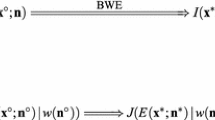Abstract.
The paper proposes the consistent and rigorous use of equivalence scales for households of different size. Equivalence scales are employed for deriving the income of an equivalent adult representing the household and for weighting the different household types. The proceeding takes into account the possibilities and the needs of different household types at the same time and seems to be adequate if income distributions are to be compared in terms of social welfare or inequality. The approach allows to define and to investigate the usual concepts (Lorenz curve, Lorenz dominance, social welfare function, progressive transfers etc.) for heterogeneous populations. They can be interpreted in an obvious way, and the results, well known for homogeneous populations, can be generalized. Furthermore, some unpleasant and unsatisfactory paradoxa or impossibility results, which can be found in the literature, vanish in the framework considered.
Similar content being viewed by others
Author information
Authors and Affiliations
Additional information
Received: 7 March 1997/Accepted: 4 November 1997
Rights and permissions
About this article
Cite this article
Ebert, U. Using equivalent income of equivalent adults to rank income distributions. Soc Choice Welfare 16, 233–258 (1999). https://doi.org/10.1007/s003550050142
Issue Date:
DOI: https://doi.org/10.1007/s003550050142




